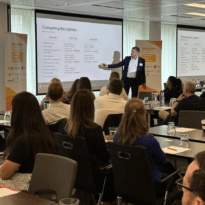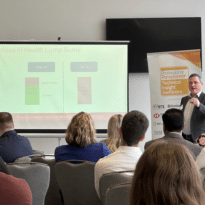EIS offer tax advantages as well as growth opportunities for advised clients. Rob Kingsbury spoke to Will Gibbs, partner at Octopus Ventures, about the recently launched Knowledge Intensive EIS Fund and what this type of EIS can offer client portfolios.
For clients who have maxed out their pensions and ISA allowances, an EIS offers additional tax advantages, as well as growth opportunities, from investing in early stage companies with the potential for substantial growth.
As well as 30% upfront income tax relief on the amount invested and tax free capital growth, they offer loss relief against income tax or capital gains tax on a company-by-company basis, which is irrespective of the overall performance of the portfolio.
In addition, shares in EIS-qualifying companies can be left to beneficiaries free from inheritance tax, provided that they have been held for two years or more at the time of death.
Knowledge Intensive (KI) EIS Funds must have at least 80% invested in companies that are carrying out research, development and innovation at the time of the investment. HMRC’s EIS rules require 50% of the money raised is invested within 12 months and 90% in 24 months.
Within an EIS Fund, companies are typically very early stage and as with any investment, they come with risk, primarily from those companies which may fail.
Will Gibbs, partner at Octopus Ventures and manager of the recently launched Knowledge Intensive EIS Fund, says the investment team is looking to invest into between 10-20 companies for the current fund. They work on an 80/20 principle – i.e. 20% of the companies invested in will drive the growth in the fund and deliver 80% of the returns. Then there will be a group of companies that deliver moderate growth, while 20-30% might fail.
Accordingly, knowledge, experience and trust in the marketplace is a key consideration when selecting a KI EIS for clients, Gibbs says. Octopus has raised over £100million in EIS in the past three years, of which two previous funds were Knowledge Intensive, launched in 2022 and 2023.
Octopus launched this third tranche of its Knowledge Intensive (KI) EIS on 15 January, which will close on 5 April 2024. Due to its structure as a Knowledge Intensive Fund, tax relief applies to the date the fund closes, not the date each of the underlying investments are made. This means investors benefit from certainty of tax relief timing. It also offers one of the last opportunities for investors to carry back to 2022/23 tax year.
Gibbs says the UK is a particularly good market for early stage companies, for three reasons. First, is a high level of technical talent in the UK; with top flight universities spinning off companies, as an example. Second, is connectivity to other markets and customers, with many major companies having UK-based arms, making the UK a good place to raise capital. Third, the UK is a good stepping off point into the US market – successful companies from Octopus EIS portfolios have moved to headquarter in the US and subsequently been acquired by US companies. Buyers have included Amazon, Microsoft and Google, Gibbs says.
The leading indicators that the investment team tracks are revenue growth and employee growth, as these indicate performance momentum and company growth. In aggregate, the companies in the first Octopus KI EIS fund, for example, have revenue growth of more than 75% and 45% growth in full time employees year on year. “This is signalling significant progress,” says Gibbs.
After a volatile period for valuations and fund performance over the past two years, Gibbs says the team is seeing “the multiples of how our companies are valued, very clearly rebound and becoming a lot healthier. This means for investors looking to invest now, they will get direct exposure to the uplift in the economic climate. Also, the portfolio companies, whilst they will grow just by their own revenue growth, should also experience the valuation multiples increase at the same time. We expect a compound positive dynamic there.”
With Octopus data showing that almost 75% of financial advisers are not using EIS, Gibbs says Octopus is trying to reposition EIS in the market. “With a maximum limit that can be invested into a KI fund at £2million a year, we think there is a general perception that it is only for large sums of money. The reality is quite different, and this is supported by advisers who have written EIS before. The average investment into our funds is £65,000-75,000. Advisers are using EIS for investors who have maxed out their pensions and ISA allowances and are looking for the next tax-advantaged product for their equity exposure.”
Key criteria that the investment team looks for, Gibbs says, is highly experienced founders that are ready to operate at pace and who can operate in multi-billion pound markets where there is the potential to build a new category leader.”
He uses a recent KI EIS fund investment, Skin+Me, a company in the dermatological/skin care space, to explain. “We invested in the company pre-launch, pre-revenue. It was a team we knew and had worked with before, and an idea we liked. There was a US company that was similar which had grown to £250m in revenue. So it was a business model that was proven and a team that was proven. And the UK dermatology market is measured in £billions.”
The company’s product has a pharmaceutical ingredient which makes it stand out in the market. “There is the potential here to move a multi-billion pound market onto a superior product, which actually gives customers what they want. The business is scaling very quickly and very efficiently,” Gibbs says.
“Typically we target 20% ownership stakes in the companies in which we invest. If we invest at the early stage and that business doubles year on year, it doesn’t take long to get to a 10x return for an individual company.”
Asked to sum up why paraplanners should be looking at KI EIS funds, Gibbs says: “KI EIS funds are a way for investors to get access to a portfolio of UK-based, high growth technology companies. By their nature these are high risk but they offer tax treatments around up front income tax and loss relief should any of the companies fail, which help manage the downside risk while also gaining exposure to tax-free equity growth from those companies.”
Main image: kanhaiya-sharma-_HdRQWJ-Pt8-unsplash


































